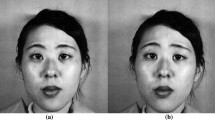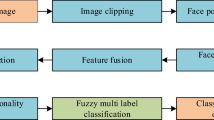Abstract
In this paper, we propose a new semantic descriptor based on axiomatic fuzzy set (AFS) to describe facial expressions. The new descriptor has two advantages: The first one is that it does not depend on priori-knowledge, when one uses it to construct semantic concepts. According to the distribution of feature data, one can quickly establish semantic concepts using the fuzzy membership degree. The second one is that the descriptor can describe complex features by implementing operation on semantic concepts. The developed descriptor can provide variations and relations of expression features. Finally, we implement our method on FEI and CK+ database, and make semantic interpretations for various expressions. Meanwhile, the performance is evaluated with the state-of-the-art methods such as C4.5, Bayes, Decision Table, Cart and Reduced error pruning tree.








Similar content being viewed by others
References
An G, Liu S, Jin Y, Ruanc Q, Lu S (2014) Facial expression recognition based on discriminant neighborhood preserving nonnegative tensor factorization and ELM. Mathematical Problems in Engineering 2014:10. doi:10.1155/2014/390328
Chakraborty A, Konar A, Chakraborty UK, Chatterjee A (2009) Emotion recognition from facial expressions and its control using fuzzy logic. IEEE Trans Syst Man Cybern Part A Syst Hum 39:726–743
Cheng S-C, Chen M-Y, Chang H-Y, Chou T-C (2007) Semantic-based facial expression recognition using analytical hierarchy process. Expert Syst Appl 33(1):86–95
Chew SW, Lucey S, Lucey P, Sridharan S, Conn JF (2012) Improved facial expression recognition via uni-hyperplane classification. 2012 I.E. Conference on Computer Vision and Pattern Recognition (CVPR), pp 2554–2561
Cootes TF, Taylor CJ, Cooper DH, Graham J (1995) Active shape models-their training and application. Comput Vis Image Underst 61:38–59
De Marsico M, Nappi M, Riccio D (2010) FARO: face recognition against occlusions and expression variations. IEEE Trans Syst Man Cybern Part A Syst Hum 40:121–132
Ding C, Peng H (2005) Minimum redundancy feature selection from microarray gene expression data. J Bioinforma Comput Biol 3:185–205
Elomaa T, Kaariainen M (2001) An analysis of reduced error pruning. J Artif Intell Res 15:163–187
Ekman P, Friesen WV (1978) Facial action coding system: a technique for the measurement of facial movement. Consulting Psychologists Press, Palo Alto, CA
Hernandez-Matamoros A, Bonarini A, Escamilla-Hernandez E, Nakano-Miyatake M, Perez-Meana H (2016) Facial expression recognition with automatic segmentation of face regions using a fuzzy based classification approach. Knowl-Based Syst 110:1–14
Huhn JC, Hullermeier E (2009) Fr3: a fuzzy rule learner for inducing reliable classifiers. IEEE Trans Fuzzy Syst 17:138–149
Huysmans J, Dejaeger K, Mues C, Vanthienen J, Baesens B (2011) An empirical evaluation of the comprehensibility of decision table, tree and rule based predictive models. Decis Support Syst 51:141–154
Kanade T, Cohn JF, Tian Y (2000) Comprehensive database for facial expression analysis. IEEE International Conference on Automatic Face and Gesture Recognition, pp 46–53
Lee SH, Ro YM (2016) Partial matching of facial expression sequence using over-complete transition dictionary for emotion recognition. IEEE Trans Affect Comput 7:389–408
Lee TS, Chiu C-C, Chou Y-C, Lu C-J (2006) Mining the customer credit using classification and regression tree and multivariate adaptive regression splines. Comput Stat Data Anal 50:1113–1130
Li Q, Ren Y, Li L, Liu W (2016) Fuzzy based affinity learning for spectral clustering. Pattern Recogn 60:531–542
Liang H, Liang R, Song M, He X (2016) Coupled dictionary learning for the detail-enhanced synthesis of 3-d facial expressions. IEEE Trans Cybern 46:890–901
Liu X (1998) The fuzzy sets and systems based on AFS structure, EI algebra and EII algebra. Fuzzy Sets Syst 95:179–188
Liu X (1998) The fuzzy theory based on afs algebras and afs structure. J Math Anal Appl 217:459–478
Liu X, Pedrycz W (2009) Axiomatic fuzzy set theory and its applications. Studies in Fuzziness and Soft Computing 244. doi:10.1007/978-3-642-00402-5
Liu X, Wang W, Chai T (2005) The fuzzy clustering analysis based on AFS theory. IEEE Trans Syst Man Cybern Part B Cybern 35:1013–1027
Liu X, Chai T, Wang W, Liu W (2007) Approaches to the representations and logic operations of fuzzy concepts in the framework of axiomatic fuzzy set theory I. Inf Sci 177:1007–1026
Liu X, Wang W, Chai T, Liu W (2007) Approaches to the representations and logic operations of fuzzy concepts in the framework of axiomatic fuzzy set theory II. Inf Sci 177:1027–1045
Lucey P, Cohn JF, Kanade T, Saragih J, Ambadar Z, Matthews I (2010) The extended cohn-kanade dataset (ck+): A complete dataset for action unit and emotion-specified expression. IEEE Computer Society Conference on Computer Vision and Pattern Recognition Workshops (CVPRW), pp 94–101
Mohammadi MR, Fatemizadeh E, Mahoor MH (2016) Intensity estimation of spontaneous facial action units based on their sparsity properties. IEEE Trans Cybern 46:817–826
Pantic M, Rothkrantz LJ (2004) Facial action recognition for facial expression analysis from static face images. IEEE Trans Syst Man Cybern Part B Cybern 34:1449–1461
Peng H, Long F, Ding C (2005) Feature selection based on mutual information criteria of max-dependency, max-relevance, and min-redundancy. IEEE Trans Pattern Anal Mach Intell 27:1226–1238
Pu X, Fan K, Chen X, Ji L, Zhou Z (2015) Facial expression recognition from image sequences using twofold random forest classifier. Neurocomputing 168:1173–1180
Quinlan JR (1993) Quinlan J R. C4. 5: Programs for machine learning. Morgan Kaufmann Publishers Inc., San Francisco
Ramoni M, Sebastiani P (2001) Robust bayes classifiers. Artif Intell 125:209–226
Ren Y, Li Q, Liu W, Li L (2016) Semantic facial descriptor extraction via axiomatic fuzzy set. Neurocomputing 171:1462–1474
RodrìGuez RM, MartıNez L, Herrera F (2013) A group decision making model dealing with comparative linguistic expressions based on hesitant fuzzy linguistic term sets. Inf Sci 241:28–42
Sarkhel R, Das N, Saha AK, Nasipuri M (2016) A multi-objective approach towards cost effective isolated handwritten bangla character and digit recognition. Pattern Recogn 58:172–189
Siebers M, Schmid U, Seuß D, Kunz M, Lautenbacher S (2016) Characterizing facial expressions by grammars of action unit sequences–a first investigation using ABL. Inf Sci 329:866–875
Silva C, Vieira SM, Sousa JMC (2015) Fuzzy decision tree to predict readmissions in intensive care unit. Lect Notes Electr Eng 321:365–373
Tenorio EZ, Thomaz CE (2011) Anàlise multilinear discriminante de formas frontais de imagens 2d de face. Proceedings of the X Simposio Brasileiro de Automacao Inteligente SBAI, pp 266–271
Thomaz CE, Giraldi GA (2010) A new ranking method for principal components analysis and its application to face image analysis. Image Vis Comput 28:902–913
Tseng JL (2016) An improved surface simplification method for facial expression animation based on homogeneous coordinate transformation matrix and maximum shape operator. Math Probl Eng 2016:14. doi:10.1155/2016/2370919
Turk MA, Pentland AP (1991) Face recognition using eigenfaces. 1991 I.E. Conference on Computer Vision and Pattern Recognition (CVPR). IEEE, Maui, p 586–591
Wang X, Liu X, Zhang L (2014) A rapid fuzzy rule clustering method based on granular computing. Appl Soft Comput 24:534–542
Wang Z, Ruan Q, An G (2016) Facial expression recognition using sparse local fisher discriminant analysis. Neurocomputing 174:756–766
Wang H, Gao J, Tong L, Yu L (2016) Facial expression recognition based on PHOG feature and sparse representation. 2016 I.E. Conference on Chinese control Conference (CCC), pp 3869–3874
Yang S, Bhanu B (2012) Understanding discrete facial expressions in video using an emotion avatar image. IEEE Trans Syst Man Cybern Part B Cybern 42:980–992
Zhang Z, Wang L, Zhu Q, Chen S-K, Chen Y (2015) Pose-invariant face recognition using facial landmarks and weber local descriptor. Knowl-Based Syst 84:78–88
Zhang K, Mistry S, Neoh C, Lim CP (2016) Intelligent facial emotion recognition using moth-firefly optimization. Knowl-Based Syst 11:248–267
Zhao G, Pietikäinen M (2007) Dynamic texture recognition using local binary patterns with an application to facial expressions. IEEE Trans Pattern Anal Mach Intell 29(6):915–928
Zhao H, Yuen PC (2008) Incremental linear discriminant analysis for face recognition. IEEE Trans Syst Man Cybern Part B Cybern 38:210–221
Zhong L, Liu Q, Yang P, Huang J, Metaxas DN (2015) Learning multiscale active facial patches for expression analysis. IEEE Trans Cybern 45:1499–1510
Acknowledgements
This work is supported by Natural Science Foundation of China (No.61370146, 61672132) and Liaoning Science & Technology of Liaoning Province of China (No.2013405003).
Author information
Authors and Affiliations
Corresponding author
Rights and permissions
About this article
Cite this article
Li, Z., Zhang, Q., Duan, X. et al. New semantic descriptor construction for facial expression recognition based on axiomatic fuzzy set. Multimed Tools Appl 77, 11775–11805 (2018). https://doi.org/10.1007/s11042-017-4818-3
Received:
Revised:
Accepted:
Published:
Issue Date:
DOI: https://doi.org/10.1007/s11042-017-4818-3




